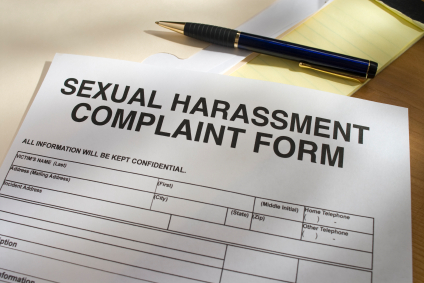The tsunami of sexual harassment allegations that has engulfed so many rich, famous and powerful men that are reported on an almost daily basis raises a fair question – How will this affect the workplace where the not so rich and famous spend their workdays helping their company succeed?
The sexual harassment incidents that arise in today’s ordinary workplace are usually more mundane than the outrageous conduct reported recently involving the Hollywood set and some in the halls of Congress. The most frequently reported complaints generally revolve around a sexually hostile environment created by one too many sexually explicit comments or jokes. On occasion it may even involve unwanted touching. Unless there is some astronomical legal judgment against an offending employer, these incidents are never the subject of television news. The more significant issue to be explored is why do such incidents continue to occur in any workplace.
The Supreme Court and Sexual Harassment
Most employers have had in place anti-harassment policies for many years. Many did so in response to the 1998 landmark decisions of the U.S. Supreme Court in Faragher vs. City of Boca Raton and Burlington Industries, Inc. vs. Ellerth. While these cases involved claims of supervisory sexual harassment, they are significant because they set out the critical elements for an employer’s affirmative defense in sexual harassment cases. The Court mandated a standard of reasonable care on the part of employers that could be met by showing that the employer:
- Implemented a policy that prohibits sexual harassment;
- Trained employees about the policy;
- Took prompt remedial action when a complaint of sexual harassment was made;
- Proved that the person complaining failed to take reasonable action to prevent the harm.
What is Sexual Harassment?
The Supreme Court has defined sexual harassment as taking one of two forms. “Quid pro quo” (Latin for “this for that”) harassment is one in which submission to the harassing conduct is made a condition of some employment aspect, promotion or continued employment for example. The second form of sexual harassment, the much more common form, known as a “hostile environment” involves conduct that is so “severe or pervasive” that a reasonable person would not tolerate it.
Since the standard for a legally actionable incident of hostile environment harassment is that it be “severe or pervasive”, an isolated or single incident of sexually explicit comments or conduct, such as unwanted touching, would not be considered unlawful in most circumstances. However, given the hyper-active climate regarding sexual harassment that we are currently experiencing, it is probable that the severe or pervasive standard will be tested if not eroded.
Both forms of sexual harassment are prohibited conduct based upon sex in violation of Title VII, the federal anti-discrimination law. That law, in existence since 1964, provides for victims of proven sexual harassment to sue their employer for damages as well as their attorney’s fees. A lawsuit is the potential culmination of a process that begins as an administrative complaint to the Equal Employment Opportunity Commission (EEOC) or its state equivalent human rights agency.
In recent years, especially in such litigation prone states as California, judgments against offending employers in a few of these cases have been in the multi-million dollar range. But even large dollar judgments may pale in comparison to the long-term financial loss of customer or client good will for an employer found to have permitted sexual harassment to occur in their workplace.
Businesses Must Address Sexual Harassment
Given the potential costs involved to employers for a proven case of sexual harassment, one would think that taking all necessary steps to prevent it, would be one of the highest priorities for most businesses. The reality is that for most employers, until they are confronted with the prospect of a six-figure legal judgement against them, simply having a no harassment policy and doing only that training mandated by some state laws is the only action they take on this high profile issue. And some employers have not even taken the fundamental step of adopting an anti-harassment policy.
This is true despite the well-documented impact of harassment on the workplace as a whole. The effects of such gender discrimination include the departure of well-qualified and productive women from the workplace, creating the need to hire and train replacements. It can also have significant financial consequences aside from legal judgments by its impact on productivity, team morale, and employee turnover in general.
If the workplace environment is to reflect that no harassment of any type will be tolerated, that message must come from the top — senior management. Sexual harassment must be taken seriously by all managers and others in position of authority. Company leaders must ask themselves whether they are fostering a company culture that breeds harassers or thwarts them. Quite often training is provided only to lower level supervisors and employees, excusing upper-level management.
The obvious message to the workforce as a whole is that anti-harassment training really isn’t that important. Similarly, using a different standard to measure the harassing conduct of managers, especially senior managers or business owners, is a sure recipe for a finding of legal liability, not to mention the detriment to employee morale.
Assuming that employees truly understand what sexual harassment actually encompasses may be in error. One would think that because of all the recent attention to the topic, everyone has a clear understanding of what conduct could violate an anti-harassment policy. However, the fact that sexual harassment claims have continued to occur in every type of workplace seems to confirm a lack of true understanding on the part of many employees.
The best way to clarify any lack of understanding is to clearly define sexual harassment, including examples of the types of behavior that is prohibited. It is critical that everyone understand that it does not always include unwelcome sexual advances or unwelcome touching. They must recognize that offensive remarks about a person’s sex, male or female, or other verbal or physical harassment of a sexual nature, is fully covered by the term. Similarly, it must be clear that male to male or female to female sexual harassment is equally prohibited.
The Government’s Response to Sexual Harassment
In 2016 the EEOC convened a Select Task Force on the Study of Harassment in the Workplace. After considerable review and analysis, that task force issued an 88 page report as well as Proposed Enforcement Guidance on Unlawful Harassment. That Guidance, which will be published in final form in the near future, tracks what have been the most commonly recognized critical elements for preventing workplace harassment. It confirms the necessity of a comprehensive no harassment policy with demonstrated accountability, both of which are consistently enforced.
It also requires a strongly committed leadership that implements and enforces truly preventative steps such as a clear and credible complaint procedure as well as training that is specifically designed for the audience in the context of the company’s unique workplace culture. Hopefully that culture becomes one in which harassment is not tolerated, notwithstanding the status of the offending employee or manager. The ultimate goal is to create a workplace that is safe, respectful and productive so that each individual employee may maximize their full potential.
Conclusion
The flood of recent scandals involving sexual harassment has shown that companies can no longer merely put an anti-harassment provision in their handbook and do the bare minimum required by the law to prevent harassment. Employers must actively look for ways to fight sexual harassment in the workplace. Businesses that fail to adapt, turn a blind eye towards inappropriate behavior, or encourage employees to “work the problem out amongst themselves” are laying the framework for a lawsuit and creating a culture that will harm their business.
———-
Richard D. Alaniz is a partner at Cruickshank & Alaniz, a labor and employment firm based in Houston. He has been at the forefront of labor and employment law for over thirty years, including stints with the U.S. Department of Labor and the National Labor Relations Board. Rick is a prolific writer on labor and employment law and conducts frequent seminars to client companies and trade associations across the country. Questions about this article, or requests to subscribe to receive Rick’s monthly articles, can be addressed to Rick at (281) 381-2219 or ralaniz@cruickshank.attorney.
Thanks for reading CPA Practice Advisor!
Subscribe Already registered? Log In
Need more information? Read the FAQs
Tags: Payroll





